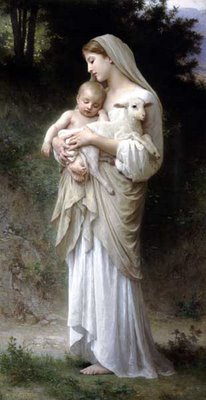Cherub Images

cher·ub
n.
- pl. cher·u·bim
- pl. cher·ubs
- A representation of a small angel, portrayed as a child with a chubby rosy face.
- A person, especially a child, with an innocent or chubby face.

A cherub ( plural cherubim) is a supernatural entity mentioned several times in the Old Testament and the Book of Revelation.
In Catholic theology the Cherubim are second highest rank in the hierarcy of angels, under the Seraphim. In popular Christian tradition, "cherub" and "cherubim" have become synonyms of "angel(s)" and especially with "baby angel(s)". Because most English speakers are unfamiliar with Hebrew plural formation, the word cherubims is sometimes incorrectly used as a plural. In English usage, cherubs is also an acceptable plural form, especially for "baby angels".
Origin Of The word Cherub
The word cherub is probably related to the Babylonian word karabu (the Akkadian kuribu), meaning to be propitious or blessed—a name appli ed to spirits who served the gods as advisors and intermediaries (De Vaux, 1961). Others connect it with kirabu, the name of the Assyrian winged-bull god. Some scholars have even suggested tentatively that the Greek word gryphon might be derived from cherub. The Greek sphinx also greatly resembles the beastly image of cherubim, and is sometimes used as an alternate term, often to denote a fallen cherub.

Cherubim in the Bible
Descriptions in the Bible vary, but in general all describe cherubim as winged creatures combining human and animal features. In the book of Genesis cherubim are described as guarding the way to the Tree of Life, east of the Garden of Eden armed with flaming swords (Genesis 3:24): "So he drove out the man; and he placed at the east of the garden of Eden cherubim, and a flaming sword which turned every way, to keep the way of the tree of life."
Exodus 26:1 attests that cherubim were embroidered on the curtains of the tabernacle. In Solomon's Temple, two olivewood sculptures of cherubim plated with gold, ten cubits high, stood wingtip-to-wingtip guarding the Ark of the Covenant; in the tabernacle, two smaller cherubim sculpted from solid gold are described as standing on the cover of the Ark facing each other (Ex 25:18). The Ark of the Covenant stood in the Holy of Holies, where the glory of God was said to reside; for this reason God is referred to in the Tanakh as "God who dwells between the cherubim". These were probably hybrid winged figures of a type common in the symbolism of the region, e.g. those depicted in the Megiddo Ivories carrying the throne of a nameless Canaanite king (Wright, 1957).
At an earlier period, when YHWH was still conceived as making physical appearances, the cherubim formed his living chariot, possibly identical with the storm-winds (Psalms 18:10, 2 Samuel 22:11): "And he rode upon a cherub and did fly: and he was seen upon the wings of the wind".















0 Comments:
Post a Comment
<< Home